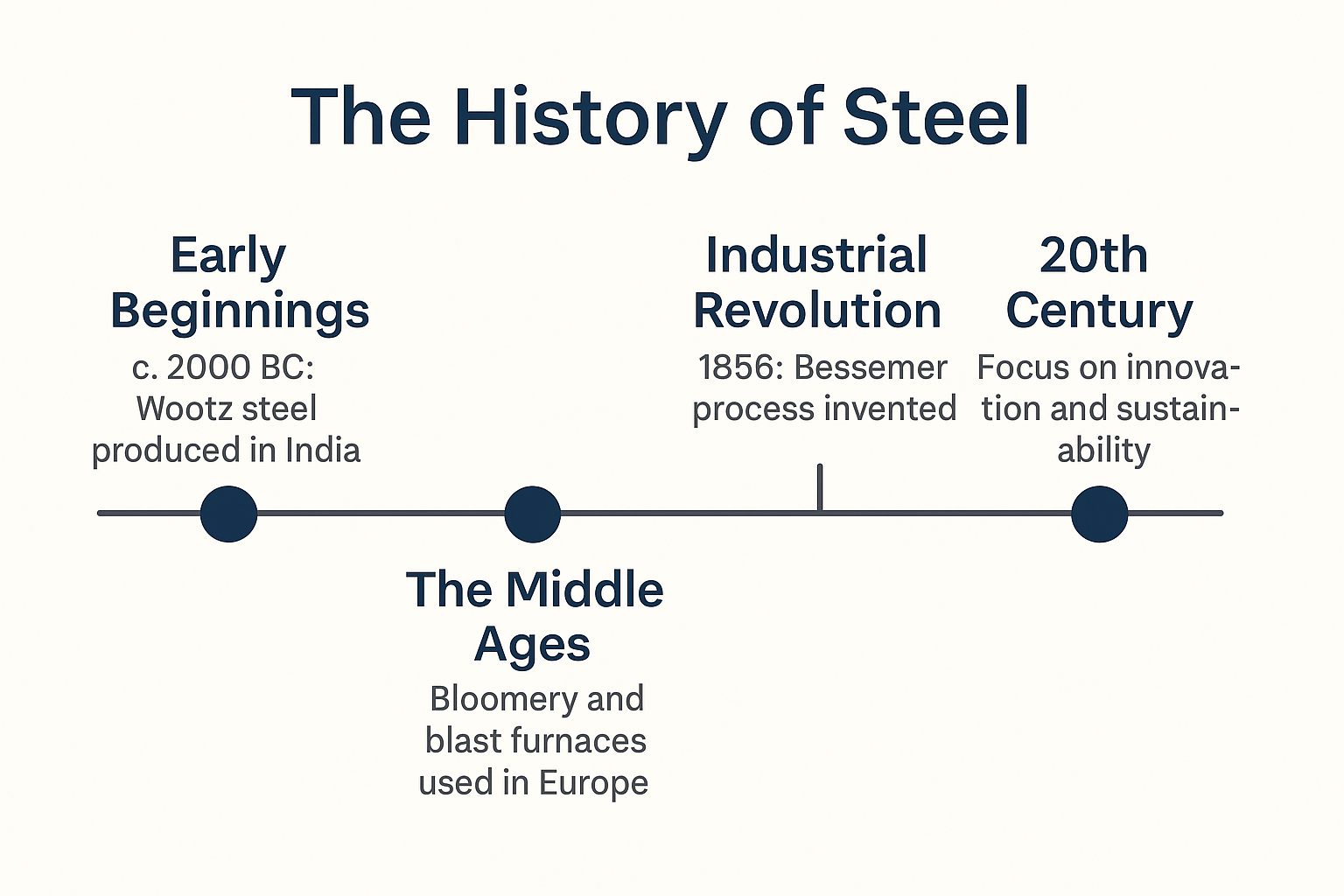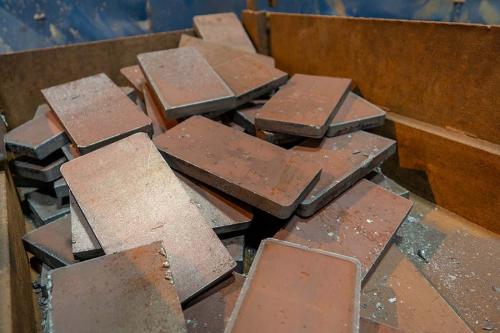Steel is a metal that is made up of an alloy of carbon and iron. Other elements are often used in the production of steel and can bring with them a wide range of features and properties. This hard metal is very strong and is used almost exclusively for structural material and fabrication.
What is Steel?
Steel is an alloy primarily composed of iron and carbon, with the carbon content typically ranging between 0.02% and 2.14% by weight. Its unique combination of strength, ductility, and versatility makes it one of the most widely used materials in construction, manufacturing, infrastructure, transportation, and countless other industries.
Composition and Types
The properties of steel are largely determined by its composition. In addition to carbon, various alloying elements like manganese, chromium, nickel, molybdenum, and vanadium are added to enhance specific characteristics such as hardness, corrosion resistance, or tensile strength. Based on its composition and properties, steel is broadly categorized into:
-
Carbon Steel – Contains varying amounts of carbon with minimal alloying elements. It is widely used in structural and construction applications.
-
Alloy Steel – Contains significant amounts of alloying elements, offering improved mechanical properties and resistance to wear and corrosion.
-
Stainless Steel – High in chromium (usually above 10.5%), offering excellent corrosion resistance and a polished appearance.
-
Tool Steel – Engineered for hardness and heat resistance, ideal for cutting and machining tools.
Manufacturing Process of Steel
Steel production begins with ironmaking, either through blast furnaces using iron ore and coke or electric arc furnaces (EAFs) that recycle scrap steel. The molten iron is then refined in steelmaking furnaces, such as the Basic Oxygen Furnace (BOF) or EAF, to adjust carbon levels and remove impurities.
After refining, steel is cast into slabs, blooms, or billets and further processed through rolling, forging, or extrusion to create products such as beams, sheets, bars, and wires.
Importance to Industry
Steel is essential to modern industry due to its:
-
High strength-to-weight ratio
-
Durability and recyclability
-
Versatile applications in sectors like construction, automotive, energy, and machinery
Its recyclability also makes steel a key player in sustainable development, with modern steelmaking emphasizing energy efficiency and reduced carbon emissions.
Steel is more than just a metal—it's the backbone of industrial progress. Its evolving compositions, adaptable properties, and sustainable production practices ensure that steel will remain a vital material in building the world of tomorrow.
Methods for Producing Steel
There are two primary methods for producing steel are through using either a Blast Furnace or an Electric Arc Furnace (EAF). Blast Furnaces have been around since sometime in the 14th century. Equipment and technology for blast furnaces have improved, but the process generally remains the same. It uses coke (cooked coal), iron ore, and limestone to produce pig iron. The pieces of coke have a high energy value that provides permeability, heat, and gasses needed to melt down the iron ore and other elements. In more modern times, natural gas is being added to the blast furnace in place of coke to reduce carbon emissions and improve sustainability.
Electric Arc Furnaces (EAFs) first appeared sometime in the late 19th century. EAFs make steel by exposing electrically charged material to an electric current being produced by terminals within the arc. This process generates heat that then begins to melt the pig iron or other scrap being used. During this process, impurities present in the molten steel float on the surface to form what is called slag. The slag is then used as a heat blanket during the refining process, and the remaining slag can be used in future refining processes. These furnaces can produce steel from 100 percent scrap, which means less energy per unit of production is needed. Compared to oxygen hearths, EAF operations can be stopped and started with little to no corresponding cost. This has caused EAF steel production to increase in recent years and now accounts for 33 percent of steel production globally and over 70 percent of steel production domestically.

The History of Steel
Steel has shaped the foundations of modern civilization—literally and figuratively. From ancient craftsmanship to today's cutting-edge industrial applications, the evolution of steel tells a story of human innovation, resilience, and progress.
Ancient Beginnings
The origins of steel date back over 4,000 years. Early forms were created when ancient blacksmiths inadvertently introduced carbon into iron during the smelting process. Around 1800 BCE, evidence from Anatolia (modern-day Turkey) shows that early steel tools were already in use. However, it was in India, around 300 BCE, where one of the earliest high-quality steelmaking techniques, Wootz steel, emerged. Renowned for its hardness and ability to hold a sharp edge, Wootz steel became the basis for the legendary Damascus steel.
Advancements Through the Ages
During the Middle Ages, steel remained rare and expensive. It was primarily used for weapons and armor. The blister steel process, developed in the 17th century, involved carburizing wrought iron, offering a more reliable method of producing steel in Europe.
The real turning point, however, came with the Industrial Revolution. As demand for stronger materials grew—especially for railways, bridges, and buildings—steel production needed to scale up.
The Bessemer Breakthrough
In 1856, Henry Bessemer revolutionized steel production with the Bessemer Process, which blew air through molten iron to remove impurities and control carbon content efficiently. This innovation drastically reduced costs and enabled mass production, marking the beginning of the modern steel industry.
Soon after, the open-hearth process and later the basic oxygen process (BOF) offered even greater control over quality and composition. In the 20th century, the electric arc furnace (EAF) transformed scrap recycling into a viable production method, helping meet global demand sustainably.
Steel in the Modern Era
From the skyscrapers of the 20th century to the automobiles, infrastructure, and clean energy technologies of today, steel has remained at the core of industrial development. The rise of stainless steel, high-strength low-alloy (HSLA) steels, and advanced high-strength steels (AHSS) showcases the industry's ongoing innovation.
Steel Types and Usages
Steel is a highly adaptable material, and its various types are engineered to meet a wide range of performance requirements. From infrastructure and automotive manufacturing to high-tech machinery and tools, the versatility of steel lies in its composition, processing methods, and tailored applications.
1. Carbon Steel
Description:
Carbon steel is the most widely used category of steel. It primarily consists of iron and carbon, with small amounts of other elements. It is classified into:
-
Low-carbon steel (mild steel): <0.3% carbon — ductile, weldable, and ideal for construction and pipelines.
-
Medium-carbon steel: 0.3–0.6% carbon — stronger and used in automotive parts and machinery.
-
High-carbon steel: >0.6% carbon — very hard and used for cutting tools and springs.
Applications:
-
Structural frameworks (buildings, bridges)
-
Pipes and tubes
-
Automotive chassis
-
Machinery components
2. Alloy Steel
Description:
Alloy steel contains significant amounts of elements like manganese, nickel, chromium, vanadium, and molybdenum, which enhance strength, toughness, wear resistance, and corrosion resistance.
Applications:
-
Gears and shafts
-
Power transmission components
-
Heavy-duty equipment
-
Offshore platforms
3. Stainless Steel
Description:
Stainless steel is highly resistant to corrosion due to its chromium content (at least 10.5%). It is also known for its aesthetic appeal, hygiene properties, and strength.
Subtypes:
-
Austenitic: Non-magnetic, corrosion-resistant (e.g., 304, 316 grades)
-
Ferritic: Magnetic and corrosion-resistant, used in automotive trim
-
Martensitic: Hard and used in cutlery, surgical tools
Applications:
-
Food processing and kitchenware
-
Medical instruments
-
Chemical and marine environments
-
Architectural structures
4. Tool Steel
Description:
Tool steels are specially formulated for hardness, resistance to abrasion, and ability to withstand high temperatures. They are often used in cutting and shaping materials.
Applications:
-
Cutting tools and dies
-
Molds for plastic injection
-
Metal stamping tools
-
Drill bits and blades
5. Specialty Steels
Examples:
-
Electrical steel: Optimized for magnetic properties in motors and transformers.
-
Weathering steel (COR-TEN): Develops a protective rust layer, used in bridges and outdoor structures.
-
High-strength low-alloy (HSLA) steel: Offers better mechanical properties and corrosion resistance with less weight.
Choosing the Right Steel
The selection of steel type depends on factors such as:
-
Mechanical properties (strength, ductility, hardness)
-
Environmental conditions (corrosive, high-temperature)
-
Fabrication processes (welding, forming, machining)
-
Cost and availability
Understanding the types of steel and their specific applications is critical in delivering the right solutions across industries. Whether it's the durability of carbon steel in buildings, the corrosion resistance of stainless steel in marine environments, or the precision of tool steel in manufacturing, steel remains the material of choice for strength, reliability, and innovation.

